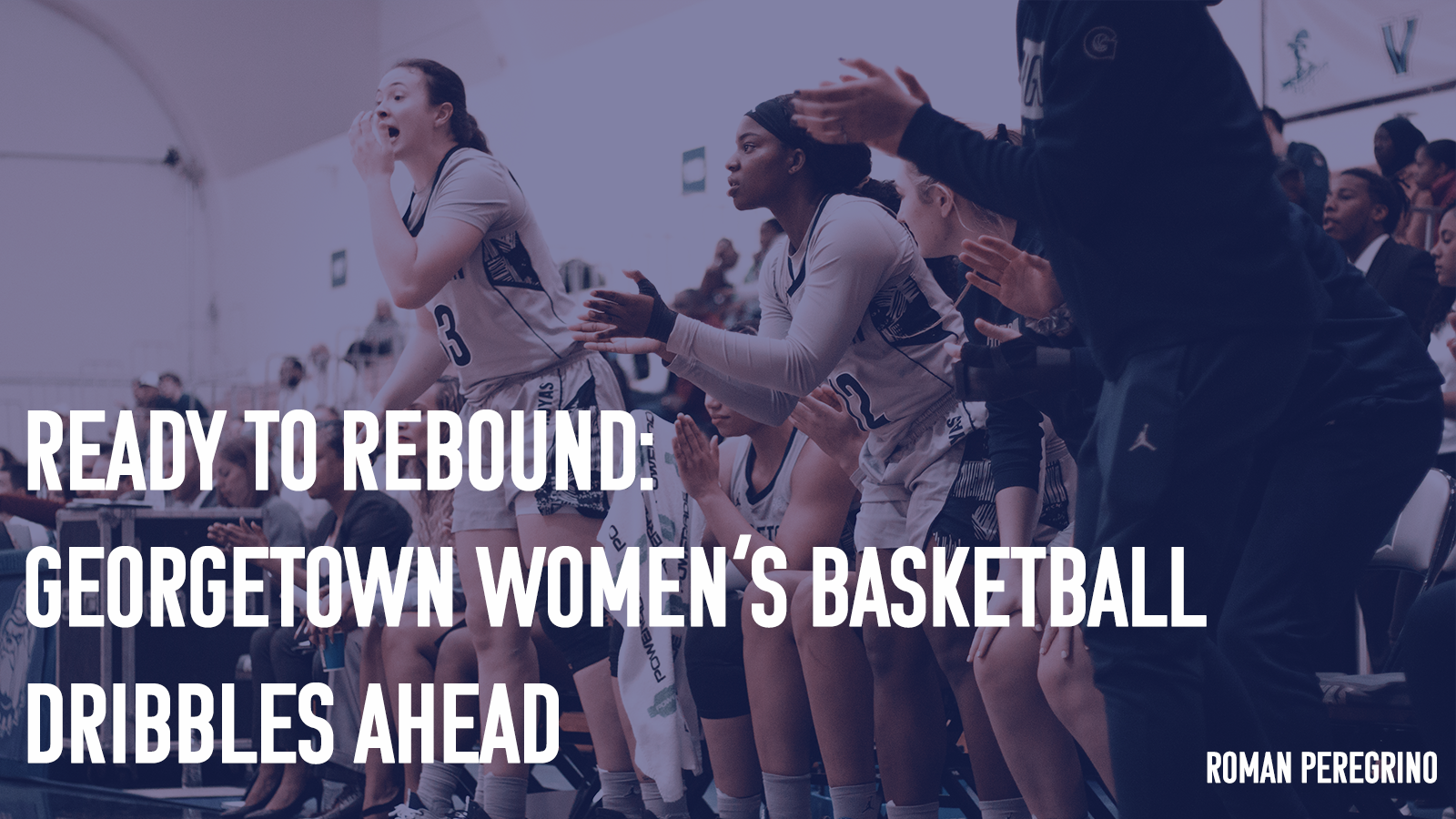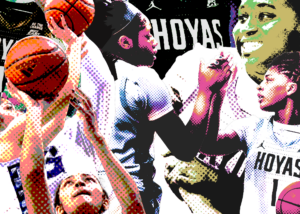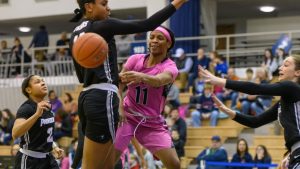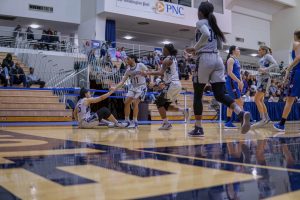When women’s basketball Head Coach James Howard walked out of Wintrust Arena on March 6, 2020, he had no idea a storm was coming. All Howard knew was his team had just dropped a close game to Providence in the first round of the Big East Tournament and there was work to be done over the offseason. That offseason never came.
By the time Howard and his team stepped back on the court at Wintrust on Dec. 19, 2020 to face DePaul in their 2020-21 season opener, everything had changed. Only two players, sophomore forward Graceann Bennett and junior forward Shanniah Wright, remained from the team that left the court nine months earlier. Due to COVID-19 restrictions, it was nearly impossible to build any chemistry or even get on the practice court, so just getting games in was an accomplishment. That the Hoyas even played most of the Big East schedule is a testament to how much the team was able to pull together.
“They went out there and they competed,” Howard said in an interview with the Voice. “Our goal this year was to compete. To play as hard as we could against some of the best teams in the country. I was proud of them for their effort.”
The team’s final record was 2-15, 2-14 Big East, and they lost in the first round of the Big East Tournament for the second straight season. However, there were undeniable bright spots on the court. Freshman guard Kelsey Ransom looked like a star, as she made the Big East All-Freshman Team and led the Hoyas in minutes, points, assists, and steals. Freshman guard Yasmin Ott struggled down the stretch, but showed her potential early in the season. Meanwhile, Bennett and transfer junior forward Jillian Archer came up big in the frontcourt, playing hard and tilting the rebound differential toward the Hoyas.
The team also made important strides off the court. Georgetown has always been a leader when it comes to social and racial justice on the college athletics scene, and the women’s basketball team has been no exception. Most noteworthy was a collaboration between the Hoyas and the Marquette women’s basketball team. Before a game in January, the opposing sides got together for a Zoom meeting to discuss social justice issues and brainstorm ways to leverage their platform.
“It gave our young women on both teams an opportunity to really showcase themselves and talk about all the concerns and all the problems that we have been faced with in Kenosha and then in Washington, D.C.,” Howard said at the time. “They wanted action more so than words, and I just felt like it was the most powerful thing that I have seen in my coaching career, to see intelligent young women fighting for equality and trying to figure out what they can do next to change history.”
Before tipoff, both teams stood together around the center court logo. The two coaching staffs lined the sidelines as “Lift Every Voice” played, creating a powerful and warming moment on a frigid January night in Wisconsin.
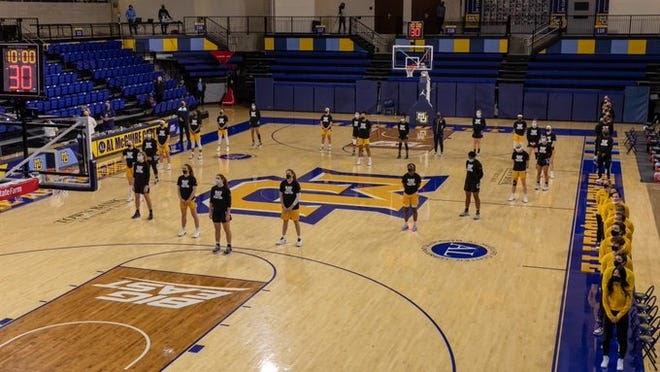
Photo Courtesy of Marquette Athletics
This joint venture was not the first occasion that the team grappled with racial justice. In the aftermath of the murders of George Floyd, Ahmaud Arbery, Breonna Taylor, and other Black Americans over the summer, several members of the team joined the university’s first Black Student-Athlete Coalition (BSAC). Senior forward Sari Cureton (who eventually opted out of the season) and several other Black athletes on campus created BSAC in the summer of 2020 in order to amplify Black voices at Georgetown, a predominantly white institution.
“These are conversations that we have to have because the people making the decisions don’t look like us,” Cureton, BSAC’s co-director of outreach and Student-Athlete Advisory Committee representative, told the Voice at the time. “When you’re at a university that’s supposed to stand for inclusion…you need to act on that when you hire people.”
The team, along with the rest of the Big East, wore Black Lives Matter patches throughout the season and participated in conference-wide initiatives. Howard and his staff also spent two weeks having discussions with the team about social injustices and how they wanted to speak out.
“We stepped away from the basketball for 14 days and we heard them. I think their voices will continue to echo to the future teams that come through here,” he said. “By taking that stand, we now know what we are standing or kneeling for. Every decision we made was as a collective unit.”
While the team had a larger social mission, they still needed to play the games. From the beginning of the year, Howard knew the main goal would be development. The team faced an incredible amount of roster turnover due to graduations, transfers, and opt-outs. Bennett and Wright, the two returners, are both traditional centers, and wound up taking the majority of the minutes at the 5 this year. Excluding their performances, 165.9 minutes per game were left to be dispersed among newcomers.
Ransom took the opportunity and ran with it. She held a starting spot from the first tipoff and would go on to total 10.5 points, 3.9 assists, and 2.2 steals per game, as well as 5.2 turnovers per game. Ransom’s freshman season was encapsulated by a painful overtime loss to Seton Hall, in which she scored 14 points, dished 10 assists, and pulled down 8 rebounds, but also had 9 turnovers, including three in the fourth quarter, as the Hoyas couldn’t hold on to a late lead.
Ransom finished the year with 66 assists and 89 turnovers, a ratio that needs to improve if she continues to be a high usage player, as will her 18 percent clip on 3-pointers. Still, Ransom was often tasked with defending the opponent’s best players and largely held her own in a conference with Paige Bueckers, Leilani Correa, and Madison Siegrist.
“She plays with a lot of heart and passion,” Howard said. “I want to see her offensive game get better. Defensively, she’s one of the top defensive guards in the conference.”
With an entire offseason of practice, Howard hopes Ransom will be able to improve her ball-handling and court vision, as the coach wants her to focus on getting her teammates involved. That also goes for Ott, Ransom’s backcourt mate who started the season hot before cooling down. Over her first two games, she shot 12 of 18 from the field (7 of 12 for three) and played nearly every minute. However, Ott was plagued with inconsistency, eventually losing her starting spot in February. Ott would go 7 of 46 from three for the rest of the season, ending with averages of 5.4 points per game and 1.4 assists per game.
To Howard, the game seemed to speed up for Ott as Big East teams adjusted. “It was a case of young players playing in the Big East versus vets,” he said. “She started out with two great games and then she became a scouting report. A lot of teams don’t know about you and then they do.”
Pushing Ott for that starting spot was January addition Milan Bolden-Morris, a graduate wing from Boston College. Bolden-Morris averaged 9.5 points per game and hit 24 threes on the year to lead the team (although only at a 26 percent clip). Unfortunately, this was her only year on the Hilltop. Two key contributors this past season who will be returning are Bennett, who averaged 6.4 rebounds and 7.5 points per game, as well as Archer, who averaged 7.3 rebounds per game and 7.9 points per game.
One big boost Howard is counting on is the return of the Croatian senior center Anita Kelava, who missed this season due to visa issues. In 2019-2020, Kelava averaged 6.6 points per game, 7.4 rebounds per game, and 1.8 blocks per game. Losing her was a big blow to the team’s frontcourt depth, especially as Howard believed she would be taking a leap.
“I felt Anita in the last 13 games in the Big East of the 2019-20 season was starting to come into her own offensively,” he said.
A full offseason and the return of Kelava are the first steps to turning the team around. This will allow the coaching staff to work on fundamentals such as shot selection and spacing, as well as strength and conditioning and film work. One of Howard’s main goals is to prepare players to finish games at a higher clip this coming year.
“We have to develop and figure out who wants to be that go-to player, who we want to have the ball in their hands in the end,” he said. “Turnovers, not being able to finish, that’s just youth.”
However, youth does not totally explain the offensive ineptitude this Georgetown team has displayed. As a whole, their 1:2 assist to turnover ratio was 306th in the nation out of 336 teams. They shot 61 percent from the free-throw line (324th in the country), 35 percent from the field (307th), and 21 percent from 3-point range (335th of 336). The team’s defensive numbers were respectable, as they held opponents to only 39 percent from the field, but it is difficult to win games without making baskets. Howard recognizes this must change.
“Our plan is to bring more veterans in here and some kids that can knock down shots,” he said. “Not shot takers, but shot makers.”
Graduate senior Mary Clougherty, a transfer from Lehigh University, should help with that. A 6’0 guard, Clougherty shot 34.5 percent from deep as a senior and will provide a veteran presence for the team, as she comes with NCAA Tournament experience. Clougherty is comfortable coming off the bench or starting, and averaged 11.9 points per game and 4.1 rebounds per game last season. Her main role will likely be to spell Ransom at the two spot this season, although her shooting abilities may keep her on the floor in crunch time. Howard told the Voice that he and his staff are in contact with several fifth-year senior ball handlers and hope to bring in at least one more veteran presence.
Besides shooting, Howard clearly prioritized length and size in his recruiting. The 2020-21 season proved that the Hoyas needed more depth in their backcourt to compete in the Big Eastm and next year will be no different, even with Kelava returning. To this end, Howard has brought in three well-regarded recruits, all over 6’2 with length and athleticism.
6’4 forward Brianna Scott out of South Lakes High School in Reston, Va. may be ready to contribute right away. Her basketball pedigree runs deep as the daughter of former Maryland basketball star Christy Winters-Scott and University of Miami player Jerome Scott. The youngest Scott earned her district’s Player of the Year award and Defensive Player of the Year award this past season as a floor-stretching big who can knock down the three as well as rebound effectively.
Kaliyah Myricks, a 6’2 forward out of Willsboro, N.J. is another young player Howard is impressed with. Myricks has a polished high-post game, which was sorely missing from the team this year, and, according to Howard, “She’s probably got the best footwork I’ve seen in a young player in a long time.”
Finally, Ariel Jenkins from Piscataway, N.J. was ranked as the 85th recruit in her class by Prospects Nation. A 6’3 forward, Jenkins is seen as a physical force in the post, gobbling up rebounds and blocking shots.
Howard said of Jenkins, “She hits the offensive glass really well. She has a nice touch and a good spot up shot.”
The 2021-22 season will be Howard’s fourth since taking over the head job. Howard is the fourth coach for the program since Terri Williams-Flournoy left after three consecutive tournament appearances from 2010-2012. While Howard has led the program to a pair of WNIT appearances, he has yet to bring them back to the Big Dance.
Moving forward, Howard’s goals are simple. He wants his squad to climb into the top five of the Big East and get back to the NCAA Tournament for the first time since 2012. Howard, like many, was impressed with the quality of play in the recent NCAA tournament.
“They really represented the game. These women are playing at a very high level,” Howard said. “That was great for the parents to understand why they do what they do for their daughters, so their daughters can have the name on the back of those jerseys. That’s what the payoff and the payback is.”
While the final results of this season are difficult to look at on paper, the Hoyas, led by Ransom, have a bright future. If a few close losses become wins, the Hoyas could become a middle-of-the-pack Big East team as soon as next season. This year’s squad has shown that they have an incredibly strong team culture, and it might soon be the names in blue and gray that are up on the national stage.


